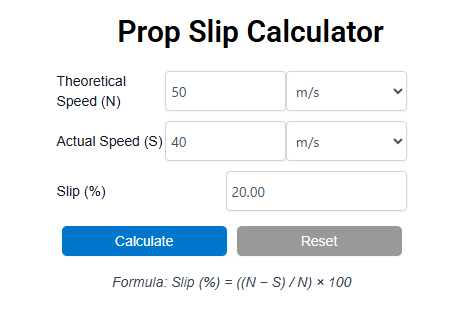Prop Slip Calculator: Calculate Prop Slip Easily
The Prop Slip Calculator is one of the most valuable tools for boat owners, helping you measure the efficiency of your propeller. By calculating prop slip, you can optimize your boat’s performance, improve fuel economy, and avoid wasting money on the wrong prop size. Whether you’re a new boater or an experienced one, understanding how to calculate prop slip can save you from costly mistakes on the water.
Prop Slip Calculator
Formula: Slip (%) = ((N − S) / N) × 100
Image Example

What is a Prop Slip Calculator and Why It Matters?
A prop slip calculator is an online tool that helps boaters determine how efficiently their boat’s propeller converts engine power into forward motion. When you calculate prop slip, you’re essentially finding out the percentage of lost efficiency caused by water resistance, cavitation, and other factors.
Without understanding prop slip, many boat owners end up with poor speed, wasted fuel, and reduced performance. For example, if your propeller slip percentage is too high, your boat will feel sluggish and underpowered. On the other hand, too little slip can lead to engine strain.
A good boat prop slip calculator gives you accurate results in seconds. By entering values such as pitch, RPM, and speed, you’ll know if your propeller is performing correctly.
👉 Learn more about boat propeller basics from Mercury Marine.
How to Calculate Prop Slip Step by Step
Understanding how to calculate prop slip is essential for every boat owner. The formula compares theoretical speed (based on prop pitch and RPM) with actual speed measured on the water. The difference between these numbers reveals your prop slip percentage.
Here’s a simplified process:
Measure your boat’s RPM and speed.
Note your propeller’s pitch.
Apply the prop slip formula or use a prop slip calculator.
If you don’t want to manually compute, our free boat prop slip calculator does all the math instantly. With accurate results, you’ll know whether your prop needs adjustment.
This method ensures you’re not wasting fuel or damaging your engine by running an inefficient setup. For more details, check out our Grow a Garden Calculator page where we explain similar calculation-based tools.
Benefits of Using a Boat Prop Slip Calculator
Using a boat prop slip calculator offers several real-world advantages:
Improved Fuel Efficiency: Correct slip means less wasted fuel.
Better Speed & Performance: Maximized propeller efficiency gives smoother rides.
Cost Savings: Avoids unnecessary prop replacements.
Engine Protection: Prevents over-revving and wear.
Many boaters overlook this step and end up spending thousands on unnecessary upgrades. By calculating prop slip early, you can make smart decisions for your boat.
Additionally, it helps you compare different propellers and choose the right one for your boating style. Whether fishing, cruising, or racing, accurate slip calculations make a difference.
👉 For deeper insights, visit BoatUS Propeller Guide.
Common Mistakes When You Calculate Prop Slip
When learning how to calculate prop slip, boat owners often make avoidable mistakes. One common issue is entering incorrect values such as speed or pitch. Even a small error can lead to misleading slip results.
Another mistake is assuming a lower slip percentage is always better. In reality, the ideal slip range varies depending on your boat type. For high-performance boats, slip should be under 10%, while for larger vessels, it can be higher.
Failing to use a reliable prop slip calculator can also mislead you. Manual calculations are prone to errors, but an online calculator ensures precision.
If you’re into DIY tools, check our Clean Time Calculator page that works on a similar principle.
Choosing the Right Propeller After Using a Prop Slip Calculator
After running a prop slip calculator, the results can guide you toward the right propeller choice. If your slip percentage is too high, switching to a propeller with a different pitch or material may solve the problem. Stainless steel props, for instance, often provide better grip in water compared to aluminum ones.
Boat owners who understand how to calculate prop slip are better equipped to make these decisions. By choosing wisely, you improve acceleration, handling, and overall boating enjoyment.
Always check your results against manufacturer recommendations. Pairing the right prop with your boat can save you from expensive mistakes and keep your time on the water stress-free.
👉 Visit Yamaha Outboards Prop Selection Guide for professional insights.
❓ Frequently Asked Questions (FAQs) About Prop Slip Calculator
1. What is a Prop Slip Calculator?
A prop slip calculator is an online tool that helps boat owners measure propeller efficiency. By comparing theoretical speed with actual speed, it calculates the slip percentage. This tells you how much performance is lost due to water resistance and prop design.
2. How do you calculate prop slip?
To calculate prop slip, you compare your boat’s theoretical speed (based on pitch and RPM) with its actual speed on the water. The difference shows the slip percentage. While you can do the math manually, a boat prop slip calculator gives instant and accurate results.
3. Why is calculating prop slip important?
Knowing how to calculate prop slip helps boaters optimize performance, save fuel, and avoid engine strain. A proper slip percentage ensures your boat runs smoothly, preventing costly mistakes like choosing the wrong prop size.
4. What is a good prop slip percentage?
A good slip percentage depends on your boat type. High-performance boats usually aim for under 10%, while larger cruising boats may have 15–20%. Using a prop slip calculator helps you identify whether your slip is within a healthy range.
5. Can I use a boat prop slip calculator for any boat?
Yes, a boat prop slip calculator works for almost any boat with a propeller. As long as you know your speed, pitch, and RPM, you can calculate prop slip accurately. This makes it a versatile tool for fishing boats, cruisers, and racing boats alike.